FALL OF ROME

In the A.D. 5th century,. Rome was sacked twice: first by the Visigoths in 410 and then the Vandals in 455. The final blow came in 476, when the last Roman emperor, Romulus Augustus, was forced to abdicate and the Germanic general Odoacer took control of the city. Italy eventually became a Germanic Ostrogoth kingdom. The historian Adrian Goldsworthy wrote that the barbarian invaders “struck at a body made vulnerable by prolonged decay."
Dr Peter Heather of Oxford University wrote for the BBC: In September 476 AD, the last Roman emperor of the west, Romulus Augustulus, was deposed by a Germanic prince called Odovacar, who had won control of the remnants of the Roman army of Italy. He then sent the western imperial regalia to Constantinople. The Roman empire in western Europe - a centralised superstate which had been in existence for 500 years - had ceased to exist, its single emperor replaced by upwards of a dozen kings and princes. “The vast majority of these rulers, like Odovacar himself , were non-Roman in origin. Their power was based on the control of military forces which were the direct descendents of recent immigrants into the Roman world, whether Anglo-Saxons in Britain, Goths in southern Gaul and Spain, or Vandals in North Africa. [Source: Dr Peter Heather, BBC, February 17, 2011 |::|]
In the A.D. 5th century, the authority of the Western Roman emperors became limited to Italy, and even here it was reduced to a mere shadow. The barbarians were the real power behind the throne. The Roman armies were made up mostly of barbarians, under the control of barbarian generals; and even the direction of affairs at the capital was in the hands of barbarian chiefs. The place which Stilicho the Vandal had held under Honorius, was filled by Ricimer the Goth during the last years of the empire. This chieftain commanded the foreign troops in the pay of Rome. He received the Roman title of “patrician,” which at this time was equivalent to regent of the empire. For seventeen years (455-472) Ricimer exercised absolute authority, setting up and deposing emperors at his will. The Roman Empire in the West had in fact already passed away, and nothing was now left but to extinguish its name. [Source: “Outlines of Roman History” by William C. Morey, Ph.D., D.C.L. New York, American Book Company (1901) \~]
The part which Ricimer had played as “king-maker” was now assumed by Orestes the Pannonian, who received the title of patrician. Orestes placed upon the throne his son, Romulus Augustulus, a boy six years of age. The brief reign of this prince has no other significance than the fact that it was the last. The barbarian mercenaries demanded one third of the lands of Italy, and on the refusal of Orestes, they placed their cause in the hands of Odoacer (a Herulian, or a Rugian chief). Romulus was obliged to resign his title as emperor, and word was sent to the Eastern ruler that there was no need of another separate emperor in the West. Odoacer was given the title of patrician, and ruled over Italy as the vicar of the Eastern emperor. The West was then deprived of the imperial title; and this event is called the “fall of the Western Roman Empire.” \~\
Websites on Ancient Rome: Internet Ancient History Sourcebook: Rome sourcebooks.fordham.edu ; Internet Ancient History Sourcebook: Late Antiquity sourcebooks.fordham.edu ; BBC Ancient Rome bbc.co.uk/history; Perseus Project - Tufts University; perseus.tufts.edu ; Lacus Curtius penelope.uchicago.edu; The Internet Classics Archive classics.mit.edu ; Bryn Mawr Classical Review bmcr.brynmawr.edu; Cambridge Classics External Gateway to Humanities Resources web.archive.org; Ancient Rome resources for students from the Courtenay Middle School Library web.archive.org ; History of ancient Rome OpenCourseWare from the University of Notre Dame web.archive.org ; United Nations of Roma Victrix (UNRV) History unrv.com
RECOMMENDED BOOKS:
“The New Roman Empire: A History of Byzantium” by Anthony Kaldellis (2023) Amazon.com
“The Rome that Did Not Fall” by Gerard Friell and Stephen Williams Amazon.com;
“Barbarians and Romans: The Birth Struggle of Europe, A.D. 400-700"
by Justine Davis Randers-Pehrson (1983) Amazon.com;
“Barbarian Migrations and the Roman West, 376 - 568" by Guy Halsall (2008) Amazon.com;
“Roman Barbarians: The Royal Court and Culture in the Early Medieval West” by Y. Hen | (2012) Amazon.com;
“The Plight of Rome in the Fifth Century AD (Routledge) by Mark Merrony (2019) Amazon.com;
“The World of Late Antiquity: AD 150-750" by Peter Brown and Geoffrey Barraclough (1989) Amazon.com
“Military History of Late Rome 565–602" by Dr. Ilkka Syvänne (2022) Amazon.com;
“History of the Later Roman Empire: From the Death of Theodosius I to the Death of Justinian” by J. B. Bury (2011) Amazon.com;
“Justinian's Empire: Triumph and Tragedy ” (The Fall of the Roman Empire Series, Book 4 of 4) by Nick Holmes (2022) Amazon.com;
“The Vandals” (Conquerors of the Roman Empire series)
by Simon MacDowall (2019) Amazon.com;
“The Late Roman West and the Vandals” by Frank M. Clover (1993) Amazon.com;
“The Visigoths from the Migration Period to the Seventh Century: An Ethnographic Perspective” by Peter Heather Amazon.com;
“The Darkening Age: The Christian Destruction of the Classical World” by Catherine Nixey (2017) Amazon.com
“Byzantium: The Apogee” by John Julius Norwich Amazon.com ;
“A Short History of Byzantium” by John Julius Norwich Amazon.com ;
“The Oxford History of Byzantium” by Cyril Mango Amazon.com ;
“Byzantium: The Surprising Life of a Medieval Empire” by Judith Herrin, Phyllida Nash, et al.
Amazon.com ;
“Constantinople: Capital of Byzantium” by Jonathan Harris (2017) Amazon.com;
“The Cambridge Companion to Constantinople” by Sarah Bassett Amazon.com;
“How Rome Fell: Death of a Superpower” by Adrian Goldsworthy (2009) Amazon.com
“The History of the Decline and Fall of the Roman Empire” by Edward Gibbon (1776), six volumes Amazon.com
“The Fall of the Roman Empire: A New History of Rome and the Barbarians” by Peter Heather (2005) Amazon.com
“The Fall of Rome” by Bryan Ward-Perkins (2005) Amazon.com
“Empires and Barbarians” by Peter Heather Amazon.com;
“Chronicle of the Roman Emperors: The Reign-by-Reign Record of the Rulers of Imperial Rome” by Chris Scarre (2012) Amazon.com;
“SPQR: A History of Ancient Rome” by Mary Beard (2015) Amazon.com
After the Collapse of the Roman Empire

Ostrogoth ruler Theodoric the Great
After the collapse of the Roman empire, ethnic chiefs and kings, ex-Roman governors, generals, war lords, peasant leaders and bandits carved up the former Roman provinces into feudal kingdoms. Feudalism after the Roman occupation was more controlled and structured than the loose form of feudalism that existed before the Romans arrived. Peasants were permanently assigned to "manorial estates." They provided food and labor to the aristocratic class of lords and knights in return for protection from bandits and rival kingdoms.
The Visigoth kingdoms of Spain (from 419) and France (from 507) retained Roman administration and law. A Visigoth kingdom in Spain and much of France saw a continuation of Roman administration until it was destroyed by the Muslims in 711. The Vandals were conquered by the Byzantines in 533 which turned the Mediterranean into a Byzantine lake until their North African territory was taken by them from the Muslims.
Italy was ruled by as a Byzantine colony with Gothic administrators (489-554) and then by direct control in south and by the German Lombards in the North (568-774). With election of Pope Gregory (590-604) power was divided between the papacy and the Byzantine empire. In the 8th century the Byzantine Church and the Catholic Church split for good.
Rome’s Transition to a New Germanic Civilization
The Ostrogoths (ruled Rome 454-93) and the Lombards (ruled Rome 566-68) invaded from positions in the Balkans and moved in on Rome from what is now northern Italy. As Rome declined, the power of the eastern provinces grow into the strong Byzantine Empire. People in Rome still spoke Ostrogoth as late as 1780.
How about define the relation between the East and the West after the deposition of Romulus Augustulus. Since Odoacer was made a Roman ruler under the title of patrician, and since he recognized the authority of the Eastern emperor, we might say that the Western Empire was not destroyed, but was simply reunited once more to the Eastern Empire. This would be true so far as it referred to a mere matter of legal form. But as a matter of historical fact this event does not mark a return to the old system of things which existed before the death of Theodosius, but marks a real separation between the history of the East and the history of the West. [Source: “Outlines of Roman History” by William C. Morey, Ph.D., D.C.L. New York, American Book Company (1901) \~]
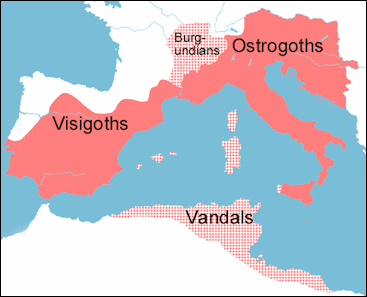
southern Europe at the time of Theodoric the Great, AD 523
The West had gradually become peopled with various German tribes. In Africa were the Vandals; in Spain and southern Gaul, the Visigoths; in northwestern Spain, the Suevi; in southeastern Gaul, the Burgundians; in Britain, the Saxons and the Jutes; in Italy, the Heruli. Only in the northern part of Gaul was the shadow of the Roman authority preserved by the governor, Syagrius, who still maintained himself for ten years longer against the invaders, but was at last conquered by the Franks under Clovis (A.D. 486). The chiefs of the new German kingdom had begun to exercise an independent authority and the Roman people had become subject to new rulers. The customs and manners of the Romans, their laws and their language, were still preserved, but upon them became engrafted new customs, new ideas, and new institutions. As the fall of the old republic was a transition to the empire, and as the decline of the early empire was a transition to a new phase of Imperialism; so now the fall of the Roman Empire in the West was in reality a transition to a new state of things out of which has grown our modern civilization.
Militarization, Balkanization and Taxation After Rome’s Collapse
Dr Peter Heather wrote for the BBC: “Everywhere you look, the fall of the Rome let loose profound change. At the heart of it all, where change at state and local level intertwined, lay the militarisation of elite landowners. The end of the Roman empire generated many states where previously there had been one, and another casualty of 476 A.D. was thus the Pax Romana. Warfare became endemic to the former Roman west. [Source: Dr Peter Heather, BBC, February 17, 2011 |::|]
“In this situation, successor state kings needed military service above all, and quickly mobilised Roman landowners with contingents of their retainers to fight alongside the descendents of their migrant warbands. But taxation had always been justified in the Roman period by the fact that it paid for defence. When successor state kings made local Roman landowners turn out for battle, not only was it a nasty shock, but it was also the ultimate double whammy. |::|
“Having to pay taxation and fight was massively unpopular - witness the stringing up of the Roman grandee Parthenius, employed by the Frankish king Chilperic as his chief tax collector in 574 AD. Kings quickly realised that they could gain much popularity by canceling tax obligations. |::|
“In the short term, they could do so since they no longer needed the money for a professional army. But in the longer term, it was precisely this process which created the new Europe of powerful local landowners and relatively powerless states, which lacked both tax revenues and professional armies, and generated the cultural change, since literacy was now so marginal to secular elite life. |::|
“It also brings us back to the peasantry. One striking feature of post-Roman archaeology is the substantial decline it demonstrates in overall population. Even if peasants don't fight, they are not immune to the effects of warfare, and declining economic opportunity also hit their capacities to make a living. Though probably not really aware of it, they too had benefited from the Pax Romana. Dark age Europe was born out of the violent destruction of the Roman empire, as the battlefield replaced the bureau at the heart of elite life, but its ramifications were felt at every social level.” |::|
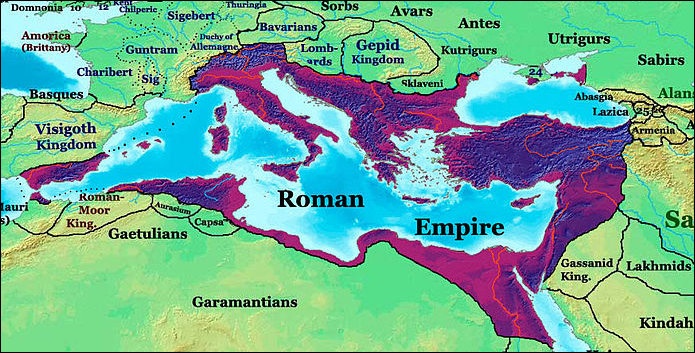
By the mid 6th century Rome was reclaimed by Romans, Roman-Byzantine Empire in AD 565
Dark Ages and Middle Ages After the Roman Empire
The Middle Ages is term which has been used to describe the period of time between the end of the Roman Empire (5th century A.D.) and the beginning of the Renaissance (15th century). This period of history has also been labeled as the "Age of Faith" with the implication that devotion to the Christian faith stunted mankind's intellectual and artistic development. At one time the "Dark Ages" was used to describe the Middle Ages until the 12th century when Gothic architecture was introduced. Now some scholars insist that it only describes the 200 year interval between the death of Justinian in the 6th century and the crowning of Charlemagne as the Holy Roman Emperor around 800 A.D. Some scholars divide the Middle Ages into two parts: the early Middle Ages, the so called Dark Ages, between the end of the Roman Empire in the 5th century and the year 1000; and the late Middle Ages, between the year 1000 and the Renaissance in the 15th century. [Source: "History of Art" by H.W. Janson, Prentice Hall, Englewood Cliffs, N.J.]
Northern Europe during the Middle Ages wrote in Howard Van der Porten in National Geographic was "dominated by illiterate kings, dukes and barons, whose private armies engaged in vicious feuds and endless warfare. In the countryside millions of landless serfs were bound to drudgery and servitude." Towns were like sanctuaries. "If a serf could escape the countryside and survive a year and a day with a town' walls, he could no longer be claimed as property by a nobleman." ["The Hanseatic League" by Howard Von der Porten, October 1994]
The presence of the Romans in England and their navy on the coast kept the Germanic Angle and Saxons tribes in Denmark and northern Germany out of the British Isles. Once the Roman empire collapsed, which coincided with the western push by Germanic tribes by the Huns from the east, the Angles and Saxon migrated unchecked into England. [Source: "History of Warfare" by John Keegan, Vintage Books]
After the collapse of the Roman empire, ethnic chiefs and kings, ex-Roman governors, generals, war lords, peasant leaders and bandits carved up the former Roman provinces into feudal kingdoms. Feudalism after Roman occupation was more controlled and structure than the loose form of feudalism that existed before the Romans arrived. Peasant were permanently assigned to "manorial estates." They provided food and labor for aristocratic class of lords and knight in return for protection from bandits and rival kingdoms.
Rome Lives on in the Eastern Empire: Byzantium
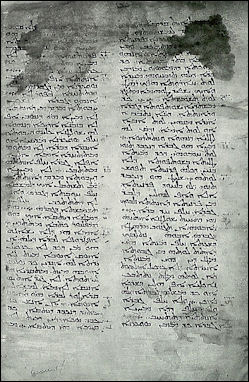
Byzantine codex When the western Roman empire collapsed, the eastern Roman empire (Byzantium) continued to thrive and many Byzantines there called themselves Romans. Dr Peter Heather wrote for the BBC: “The eastern half of the Roman empire not only survived the collapse of its western partner in the third quarter of the fifth century, but went on to thrive in the sixth. Under Justinian I (527 - 565 AD), it was still constructing hugely impressive public monuments, such as the Hagia Sophia in Constantinople, and had reconquered Italy, North Africa, and parts of Spain. “At the same time, there still lived in the west many individuals, who continued to describe themselves as Romans, and many of the successor states, it was correctly pointed out, were still operating using recognisably Roman institutions and justifying themselves ideologically with reference to canonical Roman values. Consequently, by the late 1990s the word 'transformation' had come into vogue. No one denied that many things changed between 350 and 600 AD, but it became fashionable to see these changes as much more the result of long-term evolution than of a violent imperial collapse.” [Source: Dr Peter Heather, BBC, February 17, 2011 |::|]
During of period of history when Western Europe wallowed in the Dark Ages, Byzantium flourished: Christianity was introduced to the world for the first time on a grand scale from here and great frescoes and mosaics were produced to honor the religion. Byzantium endured for 1,123 years and 18 days, until 1452 when the Ottoman Turks transported ships over a hill and captured Constantinople. At its height, the Byzantine empire embraced the entire Mediterranean basin, including present-day Greece, Italy, Spain and North Africa. Byzantine objects have been found in France, England and Denmark. Princes and lesser aristocrats placed their names on a list for a young Byzantine princess as wife. Those rejected were sometimes offered a cousin.
When the Roman empire moved to Byzantium (a Greek name) the official language of the empire was changed from Latin to Greek and Roman Law was condensed into the codex Justinianus 529 , a document that defined the legal code in Europe through the Middle Ages. The Byzantines fought battles with Persians to the east, Arabs to the south and Slavic tribes and Huns to the north. At its height around A.D. 565, the Byzantine empire ruled the Holy Land, nearly the entire Mediterranean, a large chunk of eastern Europe and most of Asia Minor. It lost the Holy Land and Egypt to Muslim invaders is the 7th century and a large portion of Asia Minor to the Turks in the 11th century."
Around the year 1000, the Byzantine embraced much of present-day Greece and Turkey and had a population of around 20 million people. The Byzantines had retaken land taken from them by the Muslims and captured new land in the Balkans.

Constantinople
Although the Byzantine period lasted for more than a thousand tears and was influential and made advances like other civilizations it's usually given a short shift by historians, compared to say, the Renaissance or ancient Rome. The historian Edward Gibbon dismissed the era as "a tedious and uniform tale of weakness and misery." The word Byzantine has came to mean overly complex and scheming.
Books: “Byzantium” by John Julius Norwich; “Short History of Byzantium” by John Julius Norwich
Constantinople and the Byzantine Empire
Constantinople was one of great cities of the world. It filled with purple cloth, gold objects and products brought from the East by the Silk Road. Constantinople was the great crossroads between east and west. Silk from China, spices from India and gold from Africa all passed through the great city on their way to Europe. The Byzantine empire financed the trade and a class of hereditary bureaucratic families grew wealthy from the taxes the empire collected. Art and architecture prospered and Constantinople's 13 miles of walls and the great chain across the Golden Horn repelled invasions by Goths, Huns, Slaves, Bulgars, Avars, Arabs and Vikings."
Constantinople was considered "the center of civilization in Christendom." It was the richest city in the world for about 800 years — from the fall of Rome in 5th century AD and the sack of the Crusades in 1204. It was so rich in ancient religious relics that when it sacked by Crusaders in 1204, they brought back two heads of John the Baptist."
Cordoba, Constantinople, Baghdad and Kaifeng in China were the greatest cities in the world around the year 1000. Largest cities in the world in the year 1000 (estimated population): 1) Cordoba, Spain (450,000); 2) Kaifeng, China (400,000); 3) Constantinople (300,000); 4) Angkor, Cambodia (200,000); 5) Kyoto, Japan (175,000); 6) Cairo (135,000); 7) Baghdad (125,000); 8) Neyshabur, Persia (125,000); 9) Al Hasa, Arabia (110,000); 10) Anhilvada, India; 11) Rayy, near modern-day Tehran (100,000); 12) Isfahan, Persia (100,000); 13) Seville, Spain (90,000); 14) Dali, China (90,000); 15) Thanjavur, India (90,000).
Roman Empire Becomes Byzantium
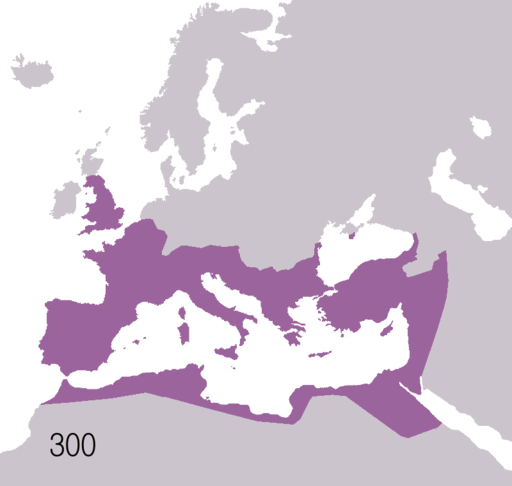
rise and fall of the Byzantine Empire The Roman empire was at its height in the second and third centuries A.D., when it included North Africa (by the conquest of Carthage in the three Punic Wars, 264-146 B.C.), the Holy Land, Egypt, Iberia (Spain), Gaul (France, conquered by Caesar in 56-49 B.C.), Britain (added in A.D. 43), Asia Minor, Macedonia (Greece) and Dacia (Yugoslavia and Bulgaria, conquered in A.D. 117)."
The Emperor Diocletian (rules A.D. 284-305) divided the Roman Empire into eastern and western sections (the divided line was west of Greece in what is now Bosnia). The move was made so that Rome could defend itself better against invading Barbarian tribes from the north, and to make administration of the vast territory easier. One half was centered around Rome and the other half was centered in Byzantium in Asia Minor.
The eastern empire flourished while the western empire declined and was whittled down by Barbarian invasions. Justinian reunited the empire briefly in the mid-6th century.
Legacy of the Roman Empire
J. A. S. Evans wrote in the New Catholic Encyclopedia: The Romans left many legacies for future generations, including a rich body of Latin literature, impressive architecture, and a system of city planning and roads, to name a few. Equally important, modern Western civilization has been greatly influenced by Roman law and the science of public administration first developed under the Romans, who saw the need to manage diverse territories efficiently.[Source: J. A. S. Evans, New Catholic Encyclopedia, Encyclopedia.com]
The most important contribution of Rome perhaps was perhaps that in taught the world how to organize itself properly. Unlike Greece which taught use how to reason, ponder and create, Rome gave us universal laws, a regular army, infrastructure, and bureaucracy. Most of cultures that were under Roman control, such as the Britons, learned little about plumbing, tools or practical architecture from the Romans. The foundation of Western civilization is based on Roman culture and leadership. Rome's enduring legacy is reflected in modern architecture, politics, urban planning, legal codes, government, medicine, sports, arts, engineering, literature, languages, our alphabet and numbers, currency and political institutions. Two months are named after Roman emperors — July after Julius Caesar and August after Augustus. The modern year of 365¼ days was introduced by Caesar.
The Romans were intent on being remembered. We know more about them than any other ancient civilization because they left behind a vast amount of literary and historical works. Much of what we know about Greece, the Greeks and Greek art is based on Roman accounts. Princeton classical scholar Frank Bourne used to tell his students, "In the age of Pax Americana , there's no more important lesson we can teach young Americans than the rise and the decline of Pax Romana ." He used to end his course with the words De Nobis fabula narratur ("Their story is our story").
Dr Peter Heather of Oxford University wrote for the BBC: For many scholars and “commentators, the fall of Rome marked the death knell of education and literacy, sophisticated architecture, advanced economic interaction, and, not least, the rule of written law. The 'dark ages' which followed were dark not only because written sources were few and far between, but because life became nasty, brutish and short. Other commentators, who were more focused on the slavery and entrenched social hierarchies that were also part of the Roman world, didn't really disagree with these observations. But they saw the 'dark ages' as a more necessary evil - Rome had to fall to destroy large-scale slavery and make possible, eventually, a world which valued all human beings more equally. [Source: Dr Peter Heather, BBC, February 17, 2011 |::|]
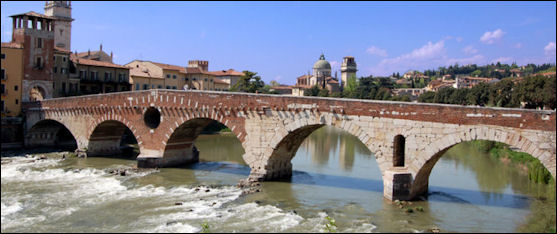
a Roman bridge that still stands in Verona
“These revisionist arguments have some real substance. There really was little change at one deep level - the life of the peasant producers who made up perhaps 90% of the population. I am still staggered by feats of Roman engineering, blown away by the beauty of some the buildings Romans lived in, and delighted by the sophistication of the empire's literary and political culture. But these cultural glories were limited to a tiny privileged elite - those who owned enough land to count as gentry landowners. They represented maybe 3% of the whole population. Its structures were probably unspeakable vile to pretty much everyone else. As late as 383 AD, captive barbarians were being fed to wild animals in the Colosseum, and its criminal law dealt ruthlessly with anyone seeking to remedy the highly unequal distribution of property. In 650 AD, as in 350 AD, peasants were still labouring away in the much the same way to feed themselves and to produce the surplus which funded everything else.”
Image Sources: Wikimedia Commons
Text Sources: Internet Ancient History Sourcebook: Rome sourcebooks.fordham.edu ; Internet Ancient History Sourcebook: Late Antiquity sourcebooks.fordham.edu ; “Outlines of Roman History” by William C. Morey, Ph.D., D.C.L. New York, American Book Company (1901) ; “The Private Life of the Romans” by Harold Whetstone Johnston, Revised by Mary Johnston, Scott, Foresman and Company (1903, 1932); BBC Ancient Rome bbc.co.uk/history/ ; Project Gutenberg gutenberg.org ; Metropolitan Museum of Art, National Geographic, Smithsonian magazine, New York Times, Washington Post, Los Angeles Times, Live Science, Discover magazine, Archaeology magazine, Reuters, Associated Press, The Guardian, AFP, The New Yorker, Wikipedia, Encyclopædia Britannica, Encyclopedia.com and various other books, websites and publications.
Last updated October 2024
